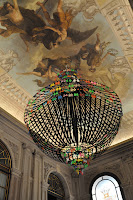As we started climbing the noble stairs we came across two female statues Eos (2013) and Aurora (2013) of exquisite beauty to which the hand-made cotton crochet covering added a distinct touch, I must confess.


As we reached the upper yard the habanera " l'Amour est un oiseau rebelle ..." sang by Maria Callas - an aria from the opera Carmen of Georges Bizet, could be heard ... as we looked up and noticed a rather beautiful thermo-lacquered iron lamp decorated with coloured plastic earrings called "Carmen" (2001), naturally allusive to the "bewitching" Carmen ... "l'Amour est un oiseau rebelle, que nul ne peut apprivoiser ..." continued the voice ... which soon echoed in the distance as we walked into the Chinese Room.

Among the artistic pieces, few of which are said to be of Chinese provenance, two caught my attention particularly, the tent shaped ceiling in two shades of intertwined natural silk and a door with Chinese- inspired motifs.

In the former Billiards' room "Stripes" (2012) brought together the well known hand-made ceramic tiles of the Factory of Viuva Lamego and an intricate organic-shaped structure of woollen crochet, which according to Joana de Vasconcelos portray the feminine world invading the masculine.
The Queen's portrait Room where the Queen's portrait stood out together with a few paintings on silk to be see on the armchairs spread around it, was chosen to exhibit "Wig" (2012) a rather exuberant structure of amaranth wood and ebony intermingled with locks of natural and artificial hair.

"Deslunado" (2004) stood at one end of the little Green Room, making it difficult to grasp the meaning behind the construction of such a structure, which according to the written information was made of various retractable washing line racks on which dozens of lamps hang upside down in a rather irreverent and yet humorous-like allegory to the unstable realm existing between interior and exterior, public and private spaces often allowing one to observe and be simultaneously observed.
In the beautifully decorated room of the Ladies of the Diplomatic Corps with its outstanding Gobelins tapestries stood the kitsch-like "Brise" (2001) - a sofa of plastic roses and the invading smell of the decorative mothballs. It wasn't until I read about the idea behind the making of this artistic piece that I realised what it was really about - "traditionally sight prevails exclusively in art, but here we are made aware of the fragility of a perception from which the other senses are denied."
In the Diplomatic Corps' Room displaying the impressive gold and silver threaded door hangings with the Tavora family's crest stood "Euro-Vision" (2005) - a TV/DVD set wrapped in cotton crochet broadcasting a copy of the 1982 Euro-vision Song Festival contest, a reminder of our participation then with a female singer quartet "Doce" (Sweet) and the song "bem bom" (really nice).


In the Throne Room possibly one of Joana de Vasconcelos's best known artistic pieces "Marilyn" (2011), an elegant pair of high-heeled shoes made of stainless steel pans and lids. The association between the private and public dimension of women, as well as what is expected of them in both spheres of life - the social and the domestic is brought to the attention of the observers who can't help but focus on these issues, whilst looking at this huge piece.


(To be continued)













No comments:
Post a Comment